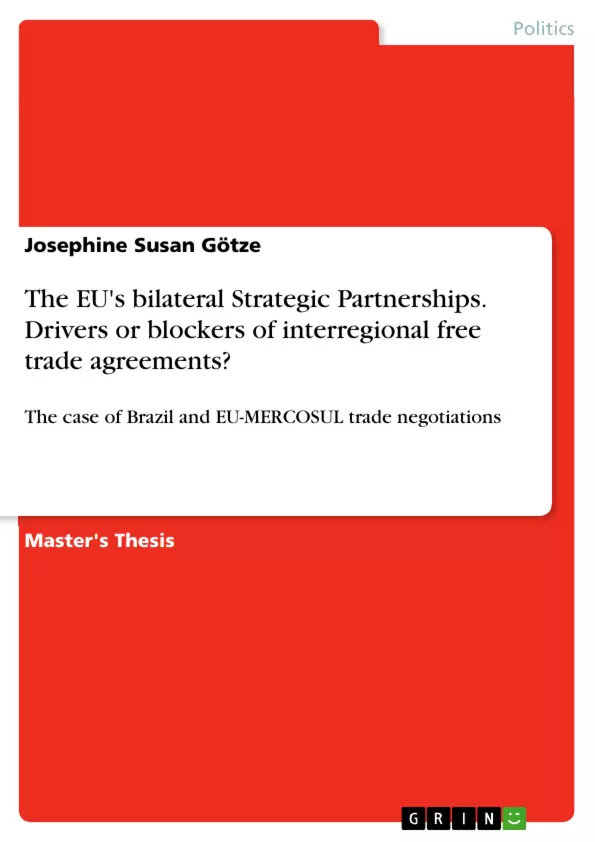At the beginning of the 21st century, the international system is characterised by ever increasing interdependence, forcing actors to re-organise their relations. The new overlapping foreign policy instruments and cooperation formats on a bilateral, (sub)regional, interregional and multilateral level, in which states pursue different strategies for the assertion of interests, result in constellations that can be favourable but are often problematic for the conclusion of free trade agreements (FTAs).
The EU, only recently having started to develop a common foreign policy and institutionalising relations with partners on a bilateral, interregional and multilateral level, is not free from this problem. Following an incoherent foreign trade policy, in which it shifts from bilateral (South Africa) to interregional (South East Asia) an mixed strategies (South America), the Union faces challenges in the conclusion of interregional FTAs. A current example is the ongoing bloc-to-bloc trade negotiations with the MERCOSUL (Mercado Comum do Sul in Portuguese or Common Market of the South in English) countries and the recent establishment of a bilateral SP with the MERCOSUL member Brazil that aims at cooperation on several topics, including trade.
In the literature, attention has been paid to regionalisation and interregionalism, as well as the duality of the EU’s biregional relations and bilateral SPs creating chances and limits of global policy-making. But although trade has played a prominent role in the study of interregional relations, attempts to link the duality of biregional and bilateral approaches in EU foreign policy with foreign trade policy-making have been modest. This study provides an in-depth analysis of the impact of the EU’s bilateral SP with third states on the Union’s ability to conclude FTAs with economic blocs the SP is integrated with. A single case study, focusing on the coexistence of interregional EU-MERCOSUL FTA negotiations and the bilateral SP between the EU and Brazil, analyses the SP’s value as an EU foreign policy instrument for the enhancement of negotiations on interregional FTAs.
Inhaltsverzeichnis (Table of Contents)
- Introduction
- Theoretical considerations
- (Neo)Liberal Institutionalism
- Interregionalism
- Research Design
- Interregionalism between the European Union and Latin America
- The European Union's foreign policy: interregionalism and trade
- Latin America and Brazilian foreign policy: regional leadership and global aspirations
- The European Union's relations towards Latin America: the broader region, MERCOSUL and Brazil
- The role of the EU's Strategic Partnerships in negotiations on interregional free trade agreements - the case of Brazil and MERCOSUL
- Independent variable one: Extent of interdependence
- MERCOSUL - a regional integration project falling short of expectations
- The low level of intraregional trade within MERCOSUL
- Interdependence and the EU
- Independent variable two: Mutuality of interests
- Interests within MERCOSUL – economic and foreign trade policies between open trade and protectionism
- Change in government – change in economic and trade policies: new chances for cooperation
- Interests and the EU – the problem of agriculture and the long-awaited window of opportunity
- Independent variable three: Distribution of power
- Brazil as an emerging power – implications of becoming a Strategic Partner for Brazil as well as for the other MERCOSUL states
- Strategic Partner Brazil's role in the re-launch of EU-MERCOSUL trade negotiations
- The EU's Strategic Partnership with Brazil and its role in EU-MERCOSUL trade negotiations
Zielsetzung und Themenschwerpunkte (Objectives and Key Themes)
This Master's thesis examines the role of the European Union's (EU) bilateral Strategic Partnerships in driving or hindering the negotiation of interregional free trade agreements. It specifically focuses on the case of Brazil and the trade negotiations between the EU and MERCOSUL.
- The influence of the EU's Strategic Partnerships on the negotiation of free trade agreements
- The interplay of interdependence, mutuality of interests, and power distribution in interregional trade relations
- The specific case of Brazil and its role within MERCOSUL in relation to EU trade negotiations
- The challenges and opportunities presented by the EU's Strategic Partnership with Brazil in the context of EU-MERCOSUL trade relations
- An analysis of the factors influencing the progress or stagnation of the EU-MERCOSUL trade negotiations.
Zusammenfassung der Kapitel (Chapter Summaries)
The thesis begins by introducing the theoretical framework, drawing upon (neo)liberal institutionalism and the concept of interregionalism. The research design is then presented, outlining the methodology and approach taken to investigate the research question. Subsequently, the thesis delves into the context of interregionalism between the EU and Latin America, examining the EU's foreign policy objectives and trade relations within this region. This section also explores Latin American and Brazilian foreign policy, emphasizing their regional leadership and global aspirations.
Moving on, the thesis specifically focuses on the role of the EU's Strategic Partnerships in facilitating or impeding interregional free trade agreements. This analysis focuses on the case of Brazil and its interactions with MERCOSUL, examining the significance of the EU's Strategic Partnership with Brazil within the context of EU-MERCOSUL trade negotiations.
To understand this dynamic, the thesis investigates three independent variables: the extent of interdependence, the mutuality of interests, and the distribution of power. Each of these variables is explored in detail, examining their influence on the negotiation process. For instance, the extent of interdependence considers the level of trade integration within MERCOSUL and the trade relationship between the EU and MERCOSUL. Mutuality of interests investigates the alignment of economic and trade policy goals between the EU and MERCOSUL member states, particularly highlighting the challenges and opportunities presented by agriculture and the changing political landscape within MERCOSUL. Finally, the distribution of power analyzes the implications of Brazil's emerging power status and its role in the EU-MERCOSUL trade negotiations.
Schlüsselwörter (Keywords)
This thesis centers on the concepts of interregionalism, Strategic Partnerships, free trade agreements, interdependence, mutuality of interests, power distribution, EU foreign policy, Latin America, Brazil, MERCOSUL, EU-MERCOSUL trade negotiations, and regional integration.
- Citation du texte
- M.A. Josephine Susan Götze (Auteur), 2018, The EU's bilateral Strategic Partnerships. Drivers or blockers of interregional free trade agreements?, Munich, GRIN Verlag, https://www.grin.com/document/432533



